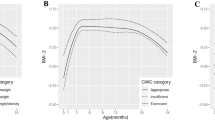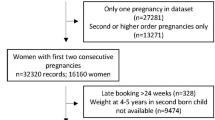Abstract
Objective:
To estimate the associations between maternal pre-pregnancy body mass index (BMI) or gestational weight change (GWC) during pregnancy and offspring BMI at 3 years of age, while taking several pre-and postnatal factors into account.
Design:
The Norwegian Mother and Child Cohort Study is a population-based pregnancy cohort study of women recruited from all geographical areas of Norway.
Subjects:
The study includes 31 169 women enrolled between 2000 and 2009 through a postal invitation sent to women at 17–18 weeks of gestation. Data collected from 5898 of the fathers were included.
Main outcome mesures:
Offspring BMI at 3 years was the main outcome measured in this study.
Results:
Mean maternal pre-pregnancy BMI was 24.0 kg m−2 (s.d. 4.1), mean GWC in the first 30 weeks of gestation was 9.0 kg (s.d. 4.1) and mean offspring BMI at 3 years of age was 16.1 kg m−2 (s.d. 1.5). Both maternal pre-pregnancy BMI and GWC were positively associated with mean offspring BMI at 3 years of age. Pre-pregnancy BMI and GWC also interacted, and the strength of the interaction between these two factors was strongly associated with the increase in offspring BMI among mothers who gained the most weight during pregnancy and had the highest pre-pregnancy BMI. Our findings show that results could be biased by not including pre-pregnant paternal BMI.
Conclusion(s):
This large population-based study showed that both maternal pre-pregnancy BMI and GWC were positively associated with mean offspring BMI at 3 years of age.
This is a preview of subscription content, access via your institution
Access options
Subscribe to this journal
Receive 12 print issues and online access
$259.00 per year
only $21.58 per issue
Buy this article
- Purchase on Springer Link
- Instant access to full article PDF
Prices may be subject to local taxes which are calculated during checkout


Similar content being viewed by others
References
Wang Y, Lobstein T . Worldwide trends in childhood overweight and obesity. Int J Pediatr Obes 2006; 1: 11–25.
Whitaker RC . Predicting preschooler obesity at birth: the role of maternal obesity in early pregnancy. Pediatrics 2004; 114: e29–e36.
Oken E . Maternal and child obesity: the causal link. Obstet Gynecol Clin North Am 2009; 36: 361–377 ix–x.
Reilly JJ, Armstrong J, Dorosty AR, Emmett PM, Ness A, Rogers I et al. Early life risk factors for obesity in childhood: cohort study. BMJ 2005; 330: 1357.
Lawlor DA, Chaturvedi N . Treatment and prevention of obesity--are there critical periods for intervention? Int J Epidemiol 2006; 35: 3–9.
Stettler N, Iotova V . Early growth patterns and long-term obesity risk. Curr Opin Clin Nutr Metab Care 2010; 13: 294–299.
Ong KK . Size at birth, postnatal growth and risk of obesity. Horm Res 2006; 65 (Suppl 3): 65–69.
Gluckman PD, Lillycrop KA, Vickers MH, Pleasants AB, Phillips ES, Beedle AS et al. Metabolic plasticity during mammalian development is directionally dependent on early nutritional status. Proc Natl Acad Sci USA 2007; 104: 12796–12800.
Schack-Nielsen L, Michaelsen KF, Gamborg M, Mortensen EL, Sorensen TI . Gestational weight gain in relation to offspring body mass index and obesity from infancy through adulthood. Int J Obes 2010; 34: 67–74.
Oken E, Taveras EM, Kleinman KP, Rich-Edwards JW, Gillman MW . Gestational weight gain and child adiposity at age 3 years. Am J Obstet Gynecol 2007; 196: 322, e1–8.
Moreira P, Padez C, Mourao-Carvalhal I, Rosado V . Maternal weight gain during pregnancy and overweight in Portuguese children. Int J Obes 2007; 31: 608–614.
Wrotniak BH, Shults J, Butts S, Stettler N . Gestational weight gain and risk of overweight in the offspring at age 7 y in a multicenter, multiethnic cohort study. Am J Clin Nutr 2008; 87: 1818–1824.
Li C, Goran MI, Kaur H, Nollen N, Ahluwalia JS . Developmental trajectories of overweight during childhood: role of early life factors. Obesity 2007; 15: 760–771.
Oken E, Rifas-Shiman SL, Field AE, Frazier AL, Gillman MW . Maternal gestational weight gain and offspring weight in adolescence. Obstet Gynecol 2008; 112: 999–1006.
Stuebe AM, Forman MR, Michels KB . Maternal-recalled gestational weight gain, pre-pregnancy body mass index, and obesity in the daughter. Int J Obes 2009; 33: 743–752.
Lawlor DA, Smith GD, O’Callaghan M, Alati R, Mamun AA, Williams GM et al. Epidemiologic evidence for the fetal overnutrition hypothesis: findings from the mater-university study of pregnancy and its outcomes. Am J Epidemiol 2007; 165: 418–424.
Olson CM, Strawderman MS, Dennison BA . Maternal weight gain during pregnancy and child weight at age 3 years. Matern Child Health J 2009; 13: 839–846.
Branum AM, Parker JD, Keim SA, Schempf AH . Prepregnancy body mass index and gestational weight gain in relation to child body mass index among siblings. Am J Epidemiol 2011; 174: 1159–1165.
Stamnes Koepp UM, Frost Andersen L, Dahl-Joergensen K, Stigum H, Nass O, Nystad W . Maternal pre-pregnant body mass index, maternal weight change and offspring birthweight. Acta Obstet Gynecol Scand 2012; 91: 243–249.
Magnus P, Irgens LM, Haug K, Nystad W, Skjaerven R, Stoltenberg C . Cohort profile: the Norwegian Mother and Child Cohort Study (MoBa). Int J Epidemiol 2006; 35: 1146–1150.
Ronningen KS, Paltiel L, Meltzer HM, Nordhagen R, Lie KK, Hovengen R et al. The biobank of the Norwegian Mother and Child Cohort Study: a resource for the next 100 years. Eur J Epidemiol 2006; 21: 619–625.
Irgens LM . The Medical Birth Registry of Norway. Epidemiological research and surveillance throughout 30 years. Acta Obstet Gynecol Scand 2000; 79: 435–439.
Norwegian Institute of Public Health. The Norwegian Mother and Child Cohort Study. Norwegian Institute of Public Health: Oslo, Norway.
World Health Organization. Obesity: Preventing and Managing The Global Epidemic. World Health Organization: Geneva, Switzerland, 2000.
Shrier I, Platt RW . Reducing bias through directed acyclic graphs. BMC Med Res Methodol 2008; 8: 70.
Cole TJ, Bellizzi MC, Flegal KM, Dietz WH . Establishing a standard definition for child overweight and obesity worldwide: international survey. BMJ 2000; 320: 1240–1243.
Gillman MW . Developmental origins of health and disease. N Engl J Med 2005; 353: 1848–1850.
Kivimaki M, Lawlor DA, Smith GD, Elovainio M, Jokela M, Keltikangas-Jarvinen L et al. Substantial intergenerational increases in body mass index are not explained by the fetal overnutrition hypothesis: the Cardiovascular Risk in Young Finns Study. Am J Clin Nutr 2007; 86: 1509–1514.
Fleten C, Nystad W, Stigum H, Skjærven R, Lawlor D, Smith GD et al. Parental-offspring associations of body mass index in the Norwegian Mother and child Cohort Study: a family based approach to study the role of the intrauterine environment for childhood adiposity. Am J Epidemiol 2012; 176: 83–92.
Davey Smith G, Steer C, Leary S, Ness A . Is there an intrauterine influence on obesity? Evidence from parent child associations in the Avon Longitudinal Study of Parents and Children (ALSPAC). Arch Dis Child 2007; 92: 876–880.
Crozier SR, Inskip HM, Godfrey KM, Cooper C, Harvey NC, Cole ZA et al. Weight gain in pregnancy and childhood body composition: findings from the Southampton Women's Survey. Am J Clin Nutr 2010; 91: 1745–1751.
Andersen CS, Gamborg M, Sorensen TI, Nohr EA . Weight gain in different periods of pregnancy and offspring’s body mass index at 7 years of age. Int J Pediatr Obes 2011; 6: e179–e186.
Nilsen RM, Vollset SE, Gjessing HK, Skjaerven R, Melve KK, Schreuder P et al. Self-selection and bias in a large prospective pregnancy cohort in Norway. Paediatr Perinat Epidemiol 2009; 23: 597–608.
Amorim AR, Linne Y, Kac G, Lourenco PM . Assessment of weight changes during and after pregnancy: practical approaches. Matern Child Nutr 2008; 4: 1–13.
Acknowledgements
The provision of questionnaire data by the Norwegian Mother and Child Cohort Study are gratefully appreciated. We thank M Mattingsdal for preparing Figure 2. The Norwegian Mother and Child Cohort Study is supported by the Norwegian Ministry of Health, NIH/NIEHS (Grant no. NO1-ES-85433), NIH/NINDS (Grant no. 1 UO1 NS 047537-01) and the Norwegian Research Council/ FUGE (Grant no. 151918/S10). We are grateful to all participating families in Norway who take part in this ongoing cohort study. In addition, this study was supported by a research grant from South-Eastern Norway Regional Health Authority and Sorlandet Hospital HF. The authors work was independent of these funding sources.
Details of ethics approval
MoBa has been approved by the Norwegian Regional Committee for Ethics in Medical Research and the Data Inspectorate. Informed consent was obtained from each participant before inclusion. The approval from the Data Inspectorate was obtained in September (2003-ref 01/4325)
Author contributions
All authors have contributed substantially to this paper.
Author information
Authors and Affiliations
Corresponding author
Ethics declarations
Competing interests
The authors declare no conflict of interest.
Rights and permissions
About this article
Cite this article
Stamnes Køpp, U., Dahl-Jørgensen, K., Stigum, H. et al. The associations between maternal pre-pregnancy body mass index or gestational weight change during pregnancy and body mass index of the child at 3 years of age. Int J Obes 36, 1325–1331 (2012). https://doi.org/10.1038/ijo.2012.140
Received:
Revised:
Accepted:
Published:
Issue Date:
DOI: https://doi.org/10.1038/ijo.2012.140
Keywords
This article is cited by
-
Effect of maternal pre-pregnancy BMI and weekly gestational weight gain on the development of infants
Nutrition Journal (2019)
-
Developmental origins of nonalcoholic fatty liver disease
Pediatric Research (2014)
-
Are we attacking the wrong targets in the fight against obesity?: the importance of intervention in women of childbearing age
International Journal of Obesity (2012)



